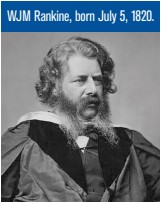When the Fourth of July celebrations are fading into the morning after the night before, please take a moment to raise a glass to Professor William Rankine on the occasion of his 200th birthday. I had hoped to be leading the celebrations with a paper on Rankine’s legacy regarding thermodynamics at the Purdue Conference the week after his birthday, but sadly that fell victim to the pandemic and has been postponed until next year.
I gave a short description of Rankine’s career and contribution to refrigeration in a previous column (December 2016). Since then, in preparing for the Purdue paper and for a conference planned for the end of July in Glasgow,* I have come to an even greater respect and admiration for the man and his legacy, particularly in engineering education and thermodynamics.
He was highly regarded as an educator not only for the clarity of his lecture courses, but also for the five major textbooks he produced over a period of about 10 years. These became popular throughout the world and were revised and reissued for many decades after his death. As a result, he was far better known in the early 20th century in the United States and Japan than he was in his home country. His books can be found in electronic form on web sites like archive.org and are still models of clarity, brevity and simplicity that should serve as the blueprint for any aspiring author of a scientific text.
In stark contrast, his work on thermodynamics was highly complex and, as one biographer said, he was “profuse in his use of algebraic symbols and profound in all kinds of equations and analysis.”† Inspired by the writings of Carnot and Clapeyron, he started work on the theory of heat and work in 1842 while still a trainee civil engineer constructing railroads and waterways in Ireland.
Using an entirely innovative thought experiment on the nature of heat, he generated a complete set of mathematical models to predict fluid properties and power cycle performance but was unable to take his work further at that time because empirical data on the properties of steam and other gases did not exist. However, when Victor Regnault of the Collège de France in Paris published his measurements of steam properties in 1848 Rankine was quick to return to the development of his theory, despite the fact that by that time he was a practicing Consulting Engineer earning his living in the design of infrastructure projects. By this time Thomson in Glasgow, Joule in Manchester, Clausius in Zurich and many others around Europe were agreeing that the old theory of heat as a weightless fluid (also called “caloric”) was
deeply flawed and the science of thermodynamics was born. Rankine’s paper “On the Mechanical Action of Heat” was presented to the Royal Society of Edinburgh in February 1850 and runs to 63 pages of densely packed logic and complex calculations. One striking feature of the paper is the extent to which he name-checks and hattips all those who came before him; some of them still household names and others lost in the mist of time.
His sense of humour shines through his technical writing, too. In a paper titled “On the want of popular illustrations of the Second law of Thermodynamics” in 1867 he wrote “The second law….has been much neglected by the authors of popular (as distinguished from elementary) works” and added a footnote “The explanation of the second law of thermodynamics in Dr Balfour Stewart’s excellent treatise on heat is elementary, but it is not, nor does it profess to be, popular.”
Happy birthday, sir! We salute you.

